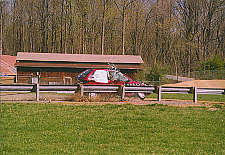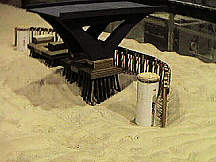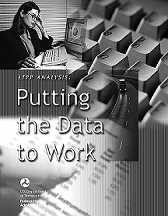U.S. Department of Transportation
Federal Highway Administration
1200 New Jersey Avenue, SE
Washington, DC 20590
202-366-4000
Federal Highway Administration Research and Technology
Coordinating, Developing, and Delivering Highway Transportation Innovations
|
Research & Technology Transporter This newsletter is an archived publication and may contain dated technical, contact, and link information. |
|
| Publication Number: N/A Date: September 1999 |
Publication Date: September 1999
|
 |
| W-beam guardrail just after the impact. |
Researchers at FHWA's Federal Outdoor Impact Laboratory, in McLean, VA, recently conducted a crash test involving a W-beam guardrail and a 820-kg car. Researchers ran the test to provide data for validating a finite element model of a Geo Metro sedan and to investigate the potential for wheel snagging problems for small cars. The guardrail was a modified G4(1s) system that had its steel blockouts replaced with 150 mm by 200 mm (6-in by 8-in) routed wood blockouts.
The small car struck the guardrail at 100.5 km/h at an impact angle of 20.5 deg and was smoothly redirected at an exit angle of 5.5 deg. The angle was shallow enough that, had the vehicle been traveling on a roadway, it would not have intruded into adjacent traffic lanes. Some minor wheel snagging occurred during the test at post number 3.
The dummy in the right front seat of the vehicle leaned toward the door upon impact and shattered the window with its head. The airbags were active, but did not deploy.
The calculated occupant impact velocities and ridedown accelerations were below the limiting values specified in the National Cooperative Highway Research Program's Report No. 350 (NCHRP 350).
To date, most of the tests on W-beam guardrails have been with pickup trucks so that researchers can confirm that these roadside barriers meet the strength requirements in NCHRP 350. This test, however, demonstrated that these commonly used guardrails can also smoothly redirect small cars.
Charles McDevitt
 |
| Speakers at the opening session of the conference. (From left to right) Alan Pisarski, conference chair; Brad Edmondson, keynote speaker; Gloria Jeff, deputy administrator, FHWA; Ashish Sen, director, Bureau of Transportation Statistics |
The Transportation Research Board (TRB) held a conference to examine the daily travel habits of Americans by looking at data provided by the Nationwide Personal Transportation Survey (NPTS) and the American Travel Survey (ATS). The conference was held June 28 through July 1, 1999, and was sponsored by the Bureau of Transportation Statistics and FHWA.
Nearly 200 participants discussed topics, such as the coordination of the NPTS and ATS for data collection in the year 2000; the effects of age, gender, and life cycle on travel; geographic factors in travel; air quality issues; mode choice; travel forecasting; and survey methods.
The next NPTS and ATS data will be collected in late summer 2000.
For additional information about NPTS, please contact Susan Liss, NPTS, Project Manager at (202) 366-5060 or at susan.liss@fhwa.dot.gov. For information about the ATS, contact Heather Contrino, ATS Project Manager at heather.contrino@bts.gov.
TRB will be producing a conference proceedings report. For more information, please call the contact below.
Tom Palmerlee (202) 334-2907 tpalmerl@nas.edu
FHWA's newly released Innovative Traffic Control Technology and Practice in Europe is a product of an international technology scanning tour conducted in May 1998. The study describes successful traffic control practices used in several European countries. These traffic control practices, if applied in the United States, could help make U.S. streets and highways safer and more efficient.
 |
| American engineers visiting Europe noted that using specific freeway pavement markings, such as these markings indicating road junctions ahead on a roadway in England, is an effective traffic control practice that the United States could adopt. |
A team of 10 American traffic engineers traveled to France, Germany, Sweden, and the United Kingdom as part of FHWA's International Technology Exchange Program. Team members represented Federal, State and local governments, as well as two private research organizations. FHWA, the Transportation Research Board (TRB), and the American Association of State Highway and Transportation Officials (AASHTO) sponsored the tour.
Team members noted several traffic control practices that Europeans used effectively such as specific freeway pavement markings, variable speed control, lane control signals, intelligent speed adaptation, innovative control of intersections, and variable message signs that incorporate pictograms and recommended that these innovations be studied for adoption in the United States.
Innovative Traffic Control Technology and Practice in Europe is available on the Internet at www.international.fhwa.dot.gov.
Hana Maier (202) 366-6003 international@fhwa.dot.gov
 |
Fourteen pier/vessel impact configurations have been tested at TFHRC's hydraulic flume. |
Researchers at FHWA's Hydraulics Laboratory located at the Turner-Fairbank Highway Research Center (TFHRC) in McLean, VA, are playing a vital role in conducting scour evaluation for the proposed new Woodrow Wilson Bridge. The existing Woodrow Wilson Bridge is the only federally owned bridge on the Interstate system.
The work conducted for this bridge project will allow scientists to better determine proper foundation design and contribute to developing technology.
Researchers in FHWA's Hydraulics Laboratory have partnered with engineers from the Maryland State Highway Agency (MdSHA); Potomac Crossing Consultants; RKK; PTG; MRCE; Hardesy and Hunt; Golder and Associates; the US Geological Survey-Biological Research Division (USGS-BRD) Research Laboratory in Turners Falls, MA.; and Texas A&M University to work on the project.
This bridge offers a number of challenges that require a team effort to resolve:
|
Sterling Jones
On June 24, the Structures Laboratory at FHWA's Turner-Fairbank Highway Research Center (TFHRC) conducted the third in a series of tests on full-scale curved bridge girders. The test series will verify and validate updated equations that predict the behavior of curved steel beams.
This is the first time that any laboratory has tested full-scale curved bridge elements as an integral part of a full-size bridge. Through these tests, which involve using specimens with varying web and flange characteristics, researchers will collect an amount of empirical data that will exceed the current design specifications.
The objectives of the FHWA Curved Steel Bridge Project are to study the structural behavior of curved steel flexural members and bridges and to provide adequate information to develop and clarify design specifications.
Researchers used six large hydraulic jacks to load the test bridge to more than 157,000 kg before the specimen failed. They used four independent data collection systems with hundreds of sensors and more than 20 km of wiring to collect the data. A state-of-the-art laser scanning system mapped the surface of the test specimen in millimeters, providing highly accurate data on any deformation.
One of the innovations developed by the test team was the ability to display, in real time, test results side-by-side with predicted values.
"The test results correlate very well with the values predicted by Georgia Tech," said Sheila Duwadi, a Research Structural Engineer and Contracting Officer's Technical Representative (COTR) for the project.
The project is a cooperative venture involving FHWA, 13 States, and the steel industry. Members of the test team include HDR Engineering, Auburn University, Bridge Software Development International, Ltd., Georgia Institute of Technology, and the FHWA research and support staff (PSI).
For more information on the project contact Sheila Duwadi or William Wright at (202) 493-3024, FHWA's Office of Infrastructure R&D.
State and local governments spend more than 25 billion dollars per year on the maintenance of highways and roads. In addition, user costs due to driver delays and increased vehicle operating costs during rehabilitation often exceed agency costs, especially for facilities that experience high traffic volume. Extending the service life of overlays, a common type of pavement rehabilitation, offers agencies and users the potential for saving billions of dollars.
Whitetopping -- the placement of portland cement concrete (PCC) overlays over deteriorated asphalt concrete (AC) pavements -- is an overlay technique that has been used for more than 60 years. However, a new technology, Ultra-Thin Whitetopping (UTW), has emerged. UTW involves placing a 50-mm- to 100-mm- (2-in- to 4-in-) thick concrete overlay over AC pavements with a grid of short joints-joints that are spaced 1- to 2-m (3- to 6-ft) apart. The first experimental section of UTW was constructed in 1991 in Louisville, KY. Since then more than 170 UTW projects have been constructed.
 |
| Workers pour and finish a thin (65 mm) section of UTW overlay at TFHRC's Pavement Testing Facility. |
In the spring of 1998, under a cooperative research agreement, the American Concrete Pavement Association (ACPA) placed eight full-scale lanes of UTW overlay on previously tested AC pavements at FHWA's Pavement Test Facility (PTF) in McLean, VA. The existing pavements were in various stages of rutting distress after being tested by FHWA's accelerated load facility (ALF) machine and were milled to either of two depths (64 or 89 mm [2-1/2 or 3-1/2 in.]) prior to placement of an equal thickness of PCC overlay. The eight test sections are each 15-m (50-ft) long and 4-m (13-ft) wide, and each are equipped with strain gauges.
The goal of the study is to validate design equations and mechanistic analysis models for different joint spacings, concrete thicknesses, mixture properties (fiber-reinforced vs. plain PCC) and AC stiffness levels.
As of August 1999, researchers completed testing on five of the eight UTW sections. More than 2.8 million 54-kN (12,000-lb.) half-axle load repetitions have been applied. This is equivalent to some 10-million industry-standard 80-kN (18,000-LB) single-axle loads (ESALs). Two of the test sections were trafficked with more than 3 million ESALs, each without showing any distress. Direct comparison of results between test lanes (and validation of design equations) will be completed later, after analysis corrects for variations in materials and construction and in underlying AC pavement support.
FHWA plans to complete its test program with two ALF machines on UTW in December 1999. The 19-month test schedule was based on service life estimates from the ACPA's UTW design method and on each ALF's average load rate of 35,000 repetitions per week.
When loading of the test sections is completed in December, the field and testing data will be turned over to an outside team. The team will analyze the data and prepare the final report, under a contract from the concrete industry's Innovative Pavement Research Foundation (IPRF). IPRF and FHWA jointly administer the national concrete research program authorized by the Transportation Equity Act for the 21st Century (TEA-21). Early in 2000, FHWA expects to make a public release of a CD-ROM containing the database of the results of the UTW experiment.
A tour of the UTW experiment at FHWA's PTF will be a feature of a workshop on UTW, to be held October 4-5, 1999, in Washington, D.C. Further information on the workshop is available from ACPA at www.pavement.com.
Jim Sherwood (202) 493-3150 jim.sherwood@fhwa.dot.gov
 |
The Long-Term Pavement Performance (LTPP) program recently published LTPP Analysis: Putting the Data to Work, a 20-page document that provides an overview of LTPP's analysis program.
The new report outlines the analysis projects that FHWA will undertake in fiscal years (FY) 1999 and 2000 and will outline those projects planned through 2003. The report will also explain how individuals select National Cooperative Highway Research Program (NCHRP) projects that deal with LTPP analysis and how the projects get recommended for inclusion in the FY 1999 and FY 2000 budgets.
Analysis is a central component of the LTPP program. LTPP takes raw data collected from more than 2400 test sections of pavement throughout North America and converts it into useable information. To date, LTPP's analysis program has included a broad range of topics, such as field validation of pavement design procedures, studies of variability in traffic and materials data, and examination of pavement roughness. Findings from these analyses provide key information that help highway engineers and managers perform their day-to-day operations.
Charlie Churilla (202) 493-3142 charles.churilla@fhwa.dot.gov
"LTAP: The Smart Road to Success" was the theme of this year's Local Technical Assistance Program (LTAP) conference, held July 25-28 in Roanoke, VA. Hosted by the Virginia Transportation Technology Transfer Center, this year's conference provided an opportunity for customers and partners to come together and get feedback about LTAP.
Among the attendees at this event were 22 representatives from 12 different countries-by far the largest number of international participants. Also new to this year's event was an "Introduction to LTAP" workshop. Nelda Bravo, local team leader, planned and moderated this session, which gave approximately 60 staff members, managers, and directors who participated the chance to learn more about LTAP. Another event, "The Cracker Barrel," allowed participants to visit with individuals from several key professional associations and to learn about their roles in transportation.
Joe Toole, Director of the Office of Professional Development, moderated a panel that focused on FHWA's reorganization and on the efforts that are being made to strengthen FHWA's involvement with LTAP.
Bravo, who helped organize this year's conference, said, "The success of the conference and the Local Technical Assistance Program is directly related to the people involved in the LTAP program. In addition to the center's staff, we have incredible participation from government, industry, and academia."
Nelda Bravo (703) 235-0552 nelda.bravo@.fhwa.dot.gov

Focus -- FHWA's monthly newsletter highlighting products of the Strategic Highway Research Program (SHRP) and other highway technologies -- is newly redesigned and now available on Turner-Fairbank Highway Research Center's Web site: www.tfhrc.gov.
Web users can now check out the latest issue of Focus or look up archived issues going back to 1996.
Focus reaches a wide audience of FHWA partners in the highway community, with a print circulation of more than 11,000. Nearly half of those who read Focus work for State or local agencies, and more than a third work in private industry. Those who work in academia or for Federal agencies make up the remaining readership.
If you would like to be added to the mailing list for the printed version of Focus, please send your name, address, and phone & fax numbers to: lgpope@woodwardcom.com